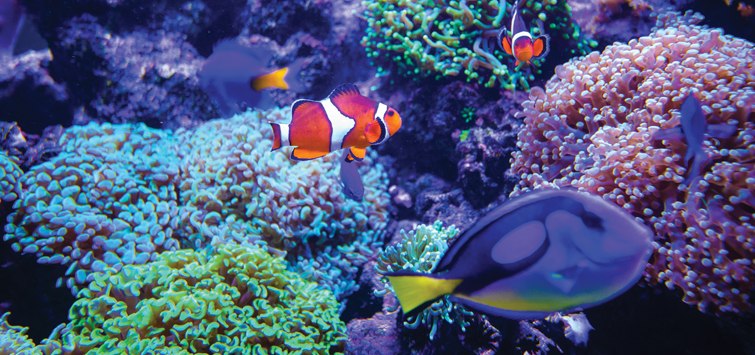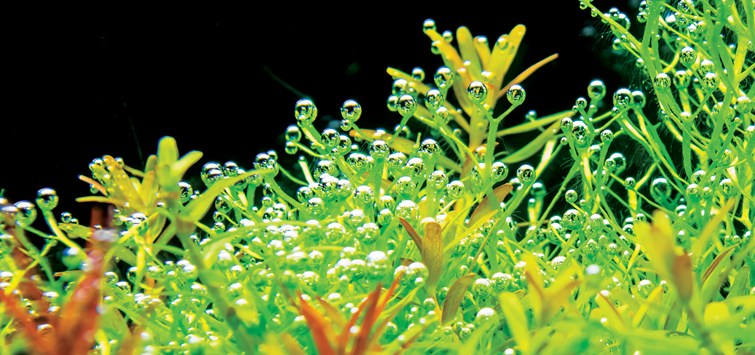A Guide to Using CO2 in Your Aquarium
Author: Jay Hemdal
Everyone who has taken a sip of soda knows that gases can be dissolved in liquids. Aquarium keepers also know that their fish require proper amounts of oxygen dissolved in their aquarium’s water for the fish to survive. Advanced aquarists are also familiar with the uses for another gas, carbon dioxide (CO2), which is used as a nutrient for growing plants in freshwater aquariums and as a means to reduce the pH of seawater flowing through calcium reactors in reef tanks.
Carbon dioxide can have another effect on aquariums, though, resulting from the level of CO2 in the air of the rooms housing them. The issue is simple: We know that elevated CO2 in the atmosphere has been implicated in harming aquatic environments, particularly coral reefs and their ability to calcify. If we consider that buildings with good insulation exchange less internal air with the outside, causing CO2 levels inside to rise above normal levels, we can surmise that aquariums in such buildings exist in similarly CO2-elevated conditions as those causing deleterious effects on aquatic life. Read on to learn how using CO2 in your aquarium can help you maintain a healthy habitat.
How to Measure CO2 in an Aquarium
Carbon dioxide is a naturally occurring compound formed by the bonding of two oxygen atoms to one carbon atom. At normal temperature and pressure, it is a gas. In 2016, the average CO2 concentration of the world’s atmosphere reached 400 parts per million (ppm), and it has been increasing over time. CO2 dissolves in water, forming carbonic acid, which can lower the pH of the water.
Aquarium water can be easily tested for the presence of excess dissolved CO2using a good quality pH meter that has been recently calibrated with the three-point buffer method. First, get an accurate measurement of the pH of the aquarium itself. Then, remove a sample of the water (a quart/liter or so is fine) and aerate it very well for 24 hours. If the starting and ending pH levels are within .02 pH units of one another, the CO2level of the aquarium is in equilibrium with that of the air space that the aquarium is housed in.
If the pH rises more than .02 pH units, however, it indicates that there is surplus CO2dissolved in the aquarium water and that additional aeration of the fish tank is warranted. Theoretically, this aeration test could also result in a corresponding rise in pH over the 24-hour time frame. The only likely cause for the aquarium’s water being lower than equilibrium with the room air would be if the sample was taken at the end of the day, in a heavily planted aquarium.
Providing CO2 for Aquarium Plants

Aquatic plants require light, nutrients, and carbon dioxide for photosynthesis. With the myriad of lighting products available today, the light requirement is easily met. Nutrients such as nitrogen and phosphorus are rarely lacking in aquariums housing fish (and if they are, they are easily supplemented). Carbon dioxide, then, is typically the factor that limits plant growth in freshwater aquariums. There are three basic ways to supplement CO2 in planted tanks: constant supply, semi-automatic, and automatic.
The constant supply method generally utilizes a yeast reaction to produce a constant low-level stream of carbon dioxide for release into the aquarium. Some resourceful aquarists use the CO2 produced by home brewing! The drawbacks to this method are the small amount of gas produced, that it is introduced to the aquarium continuously (even at night when it is not needed by the plants), and the need to frequently recharge the fermentation vessel.
The semi-automatic method utilizes a cylinder of CO2 and a timer that actuates an automatic valve. During the day, when the aquarium lights are on and the plants are actively photosynthesizing, the valve opens, delivering CO2 into the aquarium. At night, when plants are releasing carbon dioxide during reverse-phase photosynthesis, the valve is closed. This prevents wasted gas or potentially high levels of CO2 at night. Be aware that the day/night cycle has a slight lag, so the CO2valve should be set to open about an hour after the lights come on and turn off about an hour before the lights do. The drawbacks to this method are the need for refilling the gas cylinders and the relative inflexibility of the manual gas flow setting, which does not take into account changing carbon needs in the aquarium as plants grow or are pruned back.
The fully automatic system also utilizes a CO2 cylinder, but, in this case, rather than a timer, the automatic valve is actuated by a pH meter. As carbon dioxide is utilized, the pH rises. When it reaches a pre-set threshold, the valve opens, delivering carbon dioxide that in turn lowers the pH. When it reaches the low-side setting, the valve closes. This process delivers just the right amount of gas (assuming the pH range has been set appropriately). This method is the most efficient but does require careful monitoring of the pH calibration point; if the meter is reading incorrectly, the wrong amount of gas will be injected.
With all three methods, the carbon dioxide is introduced into the water through some type of diffuser that maximizes the rate that the gas goes into solution. Simply bubbling carbon dioxide into the water is wasteful, as most of the gas pops to the surface and escapes out into the room.
CO2 in Reef Tanks

Carbon dioxide gas is used by some marine aquarists to better dissolve carbonate materials into the aquarium water, increasing the bio-availability of calcium, magnesium, and other elements for growing corals. The basic process is water from the aquarium flows past a needle valve that injects carbon dioxide gas. This lowers the pH of the water and increases the ability of the water to dissolve carbonate substrate inside a reaction tube. Inside the tube is a pH probe connected to a controller that opens and closes the valve to the CO2 supply. This results in a feedback loop that maintains the pH of the water inside the reaction tube at a predetermined level. A good starting point is a pH pf 6.5, and this can be adjusted up or down depending on the specific conditions in the aquarium.
Calcium reactors are a good way to supplement marine aquariums with sufficient calcium to replace that taken up by actively growing corals. The choice of reactor media is important, though, as materials high in phosphorus will dissolve that mineral into the water at a high rate along with the calcium. Also, the pH meter used in the process must be calibrated frequently so that the pH set point remains accurate. And, as the media dissolves, it tends to pack in the chamber, so the aquarist may need to mix it up to allow for good water flow. Finally, if you are using CO2 in an aquarium and the gas is injected at too high of a rate, free carbon dioxide can be released into the aquarium itself, with dire consequences. One way to reduce that possibility is to pass the effluent of the calcium reactor through a degassing chamber. For most home aquarists, a protein skimmer will serve that purpose well enough.
Calcium reactors have a very high initial equipment cost, as well as substantial ongoing operational costs that include replacing gas, media, pH probes, needle valves, and, possibly, solenoids.
CO2 Dangers: The Mysterious Case of the Dying Boarfish Larva
I was involved with spawning and trying to rear the very delicate larvae of the boarfish (Capros aper) and had come up against a strange obstacle. The larvae needed to be raised in static containers of water—no aeration, as the bubbles would damage them. Once a day, I needed to count the remaining fish, which were very tiny, only 1/8 inch (3 mm) in length.
As I put my nose close to the surface of the containers and began counting, some of the fish would begin to swirl to the surface and die right before my eyes. I jokingly told people that it was my ugly mug that frightened them to death, but, honestly, I was really puzzled… why would the fish die just when I looked at them?
In testing the CO2 meter, I later discovered that watching the meter from a close distance would cause a dramatic rise in the meter’s readings—sometimes by as much as 500 ppm in just a minute or so. I now suspect that what happened with the boarfish was that my breath increased the CO2in a layer of air above the boarfish rearing tank, causing a pH drop in the container’s water that affected the larvae.
Testing for Surplus CO2
I have always thought that aquariums with photosynthetic organisms, whether corals, algae, or plants, would produce a surplus of oxygen during the day and then generate a surplus of carbon dioxide at night during reverse-phase photosynthesis. After all, that’s what happens in natural environments, such as ponds. One test puts some doubt into this idea.
I wrapped an established 5-gallon (19-liter) nano reef with a plastic garbage bag, set a CO2 meter inside the bag next to the tank, and began taking readings. Since the tank lights had been on for a number of hours, I fully expected the CO2 level in the air around the tank to soon begin dropping. Actually, the carbon dioxide level started at 875 ppm and climbed to 1020 ppm five hours later. Upon removing the plastic bag, the CO2 level dropped to 815 ppm within 15 minutes.
It was obvious that this aquarium needed to vent a surplus of CO2, even during times of active photosynthesis. Does this same scenario carry over to other aquariums? Old rumors die hard, but the idea that the net carbon dioxide flux in aquariums equals out over a typical day/night cycle may not be true. It certainly wasn’t in this case.
I’ve used the CO2 meter to test the air exchange rate in rooms holding aquariums. We had some low-pH issues in aquariums housed in a holding facility, and we wanted to determine if the issue was related to air exchange between the room and the outside through the HVAC system. We took an ambient CO2 reading outdoors and then tested the air in the room. We discovered that the readings were comparable, so we ruled high carbon dioxide in the space as the cause of the depressed pH readings.
In another case, we discovered CO2 readings in a room that were greater than 800 ppm (although there were no issues related to this). Adjusting the outside air intake resolved that issue.
As an aside, the meter we have uses the “normal” atmospheric carbon dioxide level outdoors to calibrate the meter. The trouble is that this normal level was set by the factory at 375 ppm, which was a normal reading when the unit was constructed. However, today’s “new normal” of 400 ppm renders the meter inaccurate by a full 25 ppm!
In rare instances, the dissolved oxygen level of an aquarium may be at or near saturation, but artificially elevated carbon dioxide levels create symptoms in the fish that mirror those of an oxygen deficiency—rapid respiration followed by morbidity and death. There are two situations in which an aquarist is likely to see this problem: aquariums that have a carbon dioxide injector running at too high of a rate, or heavily stocked aquariums that have powerheads or canister filters whose effluents do not actively break the surface tension of the water. In the latter case, the high bioload adds carbon dioxide to the system and, because the surface tension of the water is not broken through aeration, CO2 levels increase to unhealthy levels.
Knowledge Is Key
Carbon dioxide holds many benefits for both planted and reef systems, and advanced aquarists would do well to learn and apply the principles of dissolved CO2 related to nutrient input in planted freshwater tanks and calcium dissolution in marine aquariums. But all aquarium hobbyists should have at least a basic knowledge of not only how to measure CO2 in an aquarium, and how the gas affects their tanks, whether it is purposefully introduced or already exists in the air around the aquarium.
The author is the Aquarium Curator at the Toledo Zoo and Aquarium (www.toledozoo.org/aquarium).
See the full article
on TFH Digital http://www.tfhdigital.com/tfh/jan_feb_2018/MobilePagedReplica.action?pm=2&folio=68#pg71

.png?h=595&iar=0&w=2781&hash=5FD5E69473BCC22199FBFA2FB71B6033)



